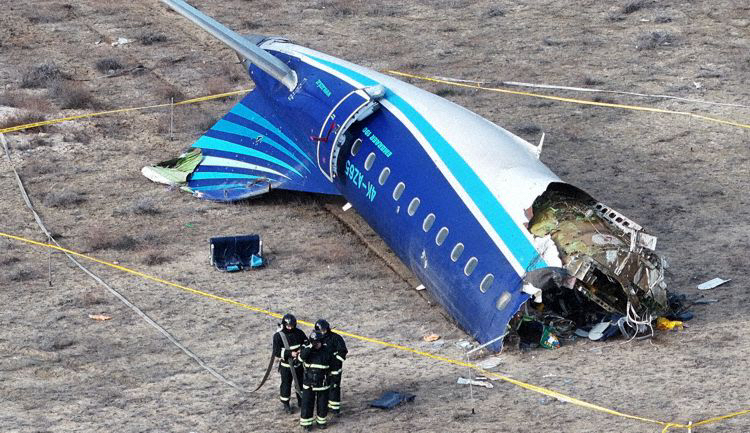Overview
• Operator: Azerbaijan Airlines
• Aircraft Model: Embraer ERJ-190
• Registration: 4K-AZ65
• Flight Number: J2-8243
• Route: Baku (Azerbaijan) → Grozny (Russia) → Aktau (Kazakhstan)
• Date: 25 December 2024
• Occupants: 67 (62 passengers, 5 crew)
• Fatalities: 38
• Survivors: 29 (including all cabin crew)
• Nature of Incident: Mid-air explosion and crash due to suspected missile strike
Incident Summary
Azerbaijan Airlines flight J2-8243, operated by an Embraer ERJ-190 (4K-AZ65), was en route from Baku (Azerbaijan) to Grozny (Russia) when it was forced to divert due to adverse weather conditions. The flight attempted to land at Makhachkala (Russia) but aborted due to fog, before finally declaring an emergency and diverting to Aktau (Kazakhstan).
While preparing for an emergency landing at Aktau, the aircraft lost altitude and impacted the ground approximately 5 km northwest of runway 11, resulting in a catastrophic crash and subsequent fire.
Rescue teams managed to save 29 people, including all flight attendants, while 38 occupants, including both pilots, perished. Initial investigations suggest the aircraft was subjected to an external impact before the crash, with evidence of structural damage resembling missile or projectile impact.
Sequence of Events
Diversion and Initial Approach Issues
• The flight originally diverted from Grozny due to severe weather conditions.
• A subsequent approach attempt to Makhachkala was aborted due to fog.
• The crew opted to return to Baku but later decided to land at Aktau due to increasing technical difficulties.
Mid-Air Catastrophic Event
• While at FL150, the cockpit voice recorder (CVR) captured a sudden sonic boom, followed by an autopilot and autothrottle disconnect alarm.
• Hydraulic system failures rendered the primary flight controls inoperative, forcing the crew to control the aircraft using engine thrust alone.
• The aft service door was reported open, and the cabin depressurized.
• Flight attendants reported two passenger seats had exploded, further indicating an external impact or projectile penetration.
Final Approach and Crash
• The aircraft was cleared for a visual approach to Aktau runway 11.
• Flaps were gradually extended, and the landing gear was deployed.
• GPWS alarms sounded, warning of terrain proximity.
• At 06:27:58Z, the aircraft impacted the ground at a 35-degree right bank with a nose-down pitch of -5.8 degrees, catching fire upon impact.
Investigation Findings & International Response
Kazakhstan’s Official Investigation
• Kazakhstan’s AAIID released a preliminary report confirming:
• Severe structural damage was found on the fuselage, vertical stabilizer, tail, and control surfaces, consistent with an external projectile impact.
• Control surfaces remained frozen at neutral positions, further indicating catastrophic hydraulic failure.
• A large number of foreign objects were found inside the aircraft, raising concerns of mid-air explosion.
International Reactions & Speculations
• Russia initially denied involvement, later admitting that their air defense systems had been actively engaging airborne threats at the time.
• Azerbaijan’s President accused Russia of an unintentional attack, demanding an independent international investigation.
• The USA offered assistance, citing preliminary intelligence suggesting a possible missile strike by Russian air defenses.
• Turkey dispatched eight investigators to assist Azerbaijan’s probe.
• IATA condemned the attack, emphasizing that civil aircraft should never be targeted in military conflicts.
Potential Causes & Technical Analysis
1. Missile or Projectile Strike
• Flight data suggests a sudden catastrophic loss of flight controls, typically seen in missile-related incidents.
• Impact damage to multiple sections of the aircraft indicates explosive fragmentation rather than mechanical failure.
2. Electronic Warfare Interference (GPS Jamming & Spoofing)
• The aircraft’s GPS receivers failed completely during approach to Grozny.
• The crew had to request an NDB approach, indicating possible GPS jamming.
• Radar data inconsistencies further suggest electronic interference.
3. Structural & Control Failures Post-Impact
• The hydraulic system failed entirely within seconds of the event, leaving the aircraft without normal flight control.
• The cabin depressurized immediately, suggesting penetration damage to the fuselage.
Safety Recommendations & Preventative Measures
• International aviation organizations must ensure strict adherence to conflict zone flight restrictions.
• Enhanced airspace monitoring and coordination should be enforced in regions with ongoing military activity.
• Reassessment of flight routes over contested airspaces is essential to prevent similar tragedies.
• Stronger diplomatic intervention is required to prevent civilian aircraft from becoming collateral damage in military conflicts.
Disclaimer
This report is based on available information as of 4 February 2025. While every effort has been made to ensure accuracy, the completeness of the details cannot be guaranteed. If you are the rightful owner of any referenced materials and wish them removed, please email takedown@cockpitking.com.
